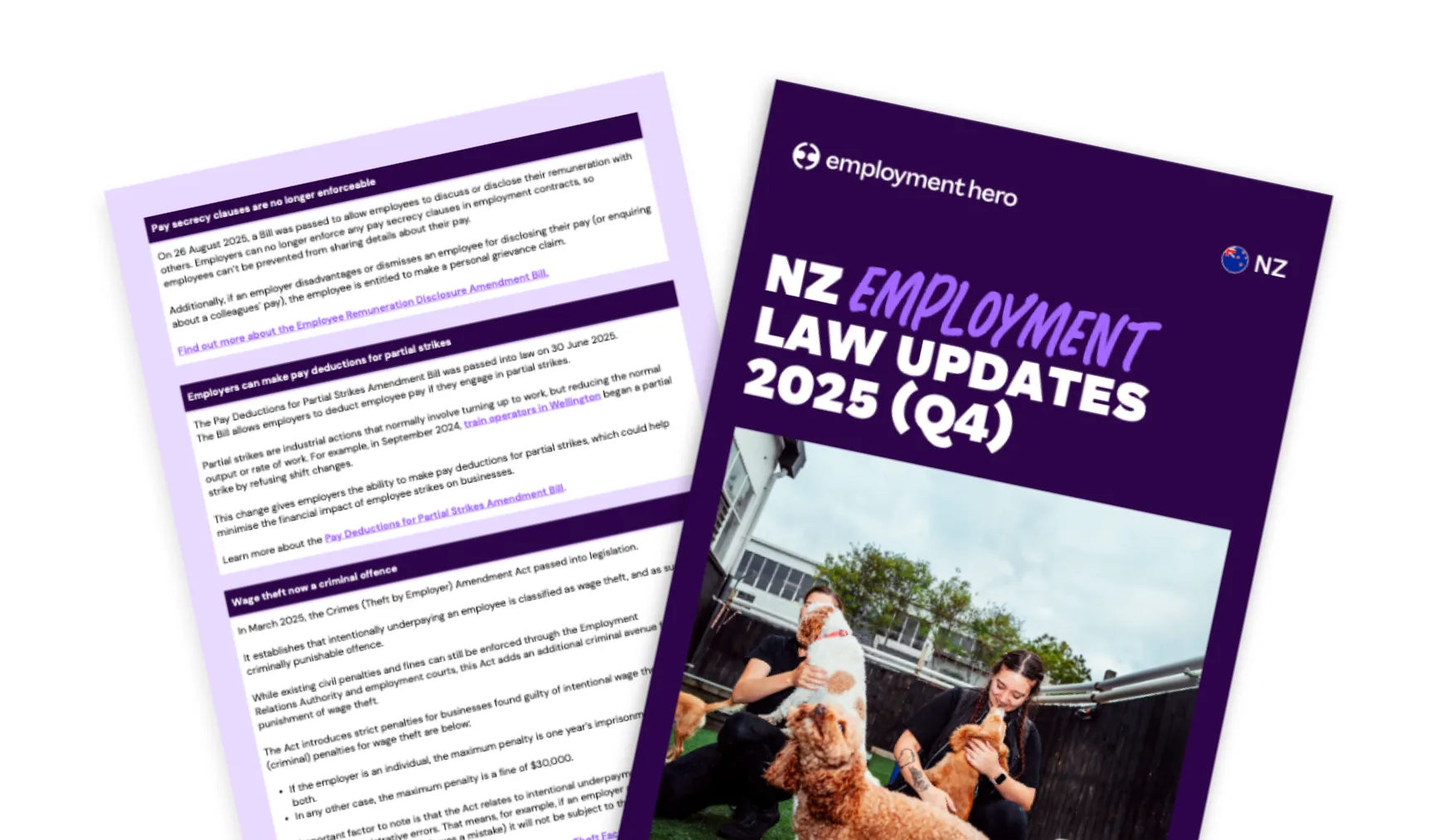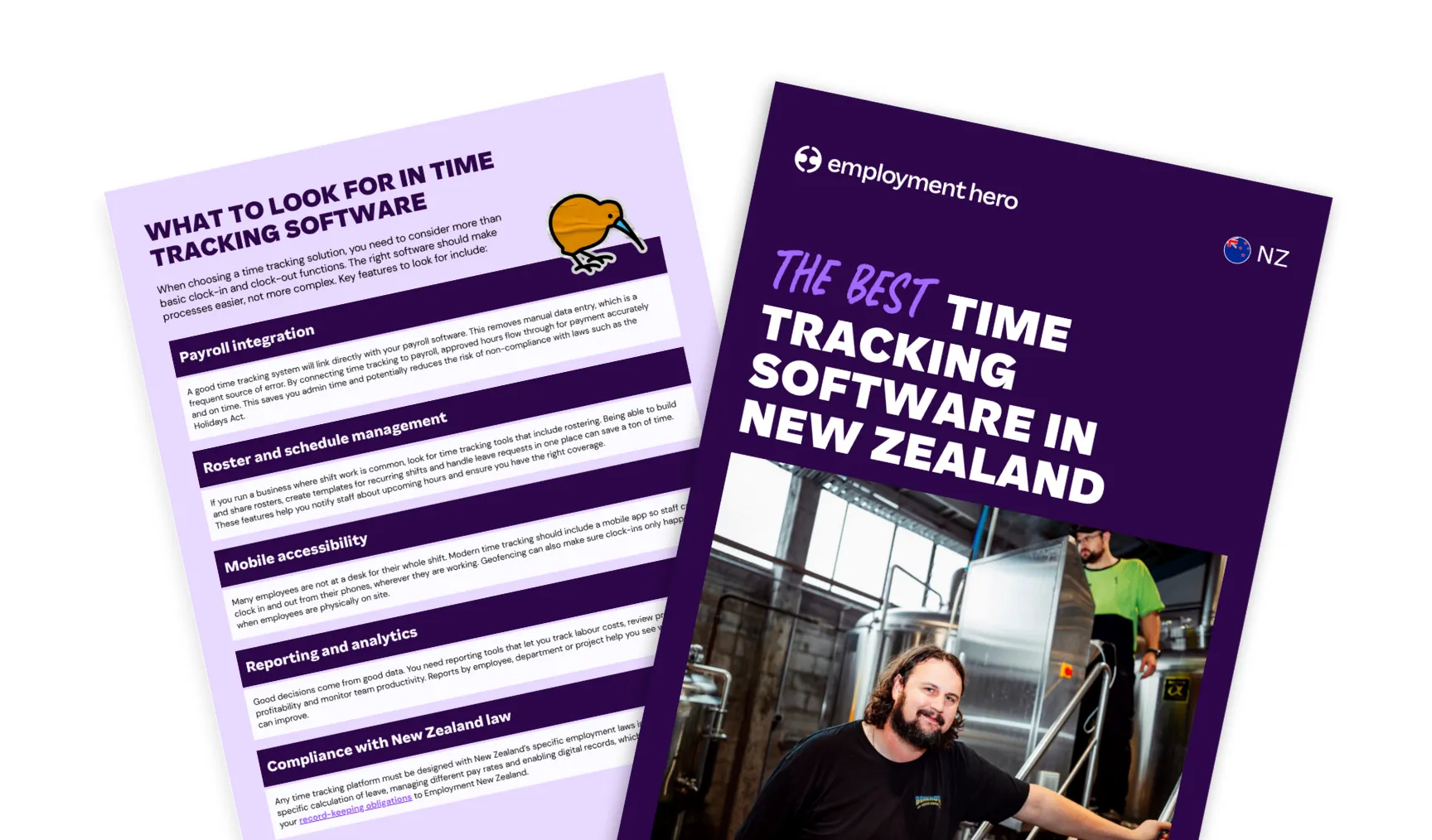Workplace health and safety induction checklist
Published
Workplace health and safety induction checklist
Health and safety – there’s no compromise. It’s crucial for workplaces to be safe because without care and risk management, the negative impact can be significant. That’s why we’ve created this induction checklist, which goes through a standard workplace health and safety (WHS) induction for a new employee. It includes steps related to the following:
- Workspace safety
- Workspace tour essentials
- Wellness and health advice
Our checklist is suitable for everyone – from manufacturing and hospitality businesses to office teams. There may be added details you need to add for your own business, but this should give you a good framework to start from.
To download the checklist, fill out the form on the right.
What is a WHS induction checklist and why is it important?
A workplace health and safety induction checklist helps ensure that new workers are properly introduced to the safety policies, procedures and potential hazards of their workplace.
It’s critical that new employees get essential safety information from day one, to prevent accidents and promote a culture of safety. Having a detailed checklist marked off also provides a documented record that an employee has received and understood the necessary safety training.
Who is responsible for WHS in the workplace?
Everyone in the workplace has a responsibility for workplace health and safety, though the level and nature of that responsibility differs based on their role.
The primary duty of care falls to the Person Conducting a Business or Undertaking (PCBU), which includes employers, companies and other organisations. The PCBU must, so far as is reasonably practicable, ensure the health and safety of their workers and others affected by their business. This includes providing a safe work environment, safe systems of work and adequate training and supervision.
However, health and safety is a shared responsibility. Workers also have a duty to take care for their own health and safety and to not adversely affect the health and safety of others. They must comply with any reasonable instruction and cooperate with any reasonable policy or procedure relating to WHS.
What are the legal obligations around WHS?
The legal obligations for workplace health and safety in New Zealand are primarily governed by the Health and Safety at Work Act 2015. The core principle of the Act is that everyone who works has a role in health and safety, with a focus on shared responsibility.
Here are the key legal obligations:
Primary duty of care
The main legal duty falls on the Person Conducting a Business or Undertaking (PCBU). The PCBU has the primary duty of care to ensure the health and safety of its workers and any other person who is affected by the work.
This duty includes, but is not exclusive to:
- Providing and maintaining a work environment without risks to health and safety.
- Providing safe systems of work.
- Ensuring the safe use, handling and storage of substances.
- Providing adequate and accessible facilities for the welfare of workers.
- Providing necessary information, training, instruction and supervision.
Shared responsibility
While the PCBU holds the primary duty, health and safety is a shared responsibility. Officers (such as company directors or senior managers) must exercise due diligence to ensure the PCBU complies with its duties.
Workers must also take reasonable care of their own health and safety, and ensure their actions do not harm others. They must also comply with any reasonable instruction or policy relating to health and safety.
Other persons at the workplace (such as visitors or customers) also have a duty to take reasonable care for their own safety.
Worker engagement and participation
The Act requires businesses to engage with workers on health and safety matters that affect them. This means workers must have a reasonable opportunity to raise health and safety issues and contribute to decision-making. This can be done directly or through elected Health and Safety Representatives (HSRs) and Health and Safety Committees (HSCs).
Notifiable events
PCBUs have an obligation to notify WorkSafe of certain events that happen in the workplace, including:
- The death of a person.
- A serious injury or illness.
- A dangerous incident (a near-miss) that exposes a person to a serious risk to their health or safety.
The PCBU must notify WorkSafe immediately after becoming aware of a notifiable event and ensure the site is not disturbed.
What are the penalties for non-compliance with WHS laws?
The penalties for non-compliance with WHS laws in New Zealand are outlined in the Health and Safety at Work Act 2015 and are tiered based on the severity of the offence. The penalties can be significant, including substantial fines and, for the most serious offences, imprisonment. For more information, visit the WorkSafe website.
What are common workplace hazards to look out for?
Workplace hazards are anything that has the potential to cause harm. Being aware of these common hazards is the first step toward preventing incidents.
Some of the most prevalent hazards include:
Manual handling
This involves lifting, carrying, pushing, and pulling objects. Improper manual handling techniques can lead to musculoskeletal injuries such as sprains and strains.
Slips, trips and falls
These are among the most frequent causes of workplace injuries. Hazards include wet floors, cluttered walkways, poor lighting and uneven surfaces.
Electrical hazards
These can cause shocks, burns, and fires. Hazards include faulty wiring, damaged equipment and overloaded power circuits.
Psychosocial hazards
These are factors in the design or management of work that can cause psychological or physical harm. They include job-related stress, bullying, violence and long work hours.
6 tips for improving workplace health and safety
Workplace health and safety is often overlooked or taken for granted, but it’s actually incredibly important for our wellbeing. After all, most of us spend a significant amount of our waking hours in the workplace.
28 April marks the World Day for Safety and Health at Work, and so in recognition of that, we’re sharing some practical tips for improving workplace health and safety.
What is the World Day for Safety and Health at Work?
The World Day for Safety and Health at Work is a day dedicated to promoting safe, healthy, and sustainable work environments for all employees around the world. It is coordinated by the International Labour Organization (ILO), and aims to raise awareness of the importance of occupational safety and health (OSH). It also encourages action to prevent work-related injuries, illnesses, and deaths.
Every year, the day has a specific theme that focuses on a particular aspect of workplace safety and health. Past themes have included mental health, chemical safety, and the prevention of occupational diseases.
How can companies raise awareness of World Day for Safety and Health at Work?
As an employer, there are many ways you can raise awareness of the World Day for Safety and Health at Work. Here are some ideas to start:
1. Use internal communication channels
Your employees may not be aware of such a day, so why not use your internal communication channels to spread awareness about it? It could be anything from company-wide emails to an All-Hands meeting, a Slack announcement and more.
Share valuable information about the importance of workplace safety and health, highlight any initiatives or programs that the company has implemented to improve safety, and encourage employees to get involved. It’s always helpful to keep workplace safety and health top of mind for everyone to reduce the risk of any unnecessary accidents.
2. Organise interactive events and activities
Organise events and activities to mark the day, such as safety demonstrations, workshops, and training sessions to raise awareness of the importance of safety and health at work. They provide employees with practical tips and tools for staying safe on the job, whilst being able to engage with each other and share their own experiences.
3. Show solidarity through social media
Utilising your social media channels to share relevant articles and resources, using hashtags related to the day, and posting photos and videos of safety demonstrations and activities is another way to drive awareness. It’s a great way to not just engage your own employees, but also your clients, prospects, industry leaders and more, by highlighting the importance of improving workplace safety.
4. Collaborate with industry groups and trade associations
When it comes to promoting workplace safety and health, the more the merrier. Collaborate with government agencies, industry groups and more by participating in joint events and campaigns to share resources and best practices. By leveraging the collective reach of your industry, you amplify the message on the importance of eliminating dangerous workplace hazards and enhancing workplace health and safety.
5. Reward and recognise safe behaviour
We can’t emphasise the importance of this enough. Reward and recognise employees who demonstrate safe behaviour and make safety a priority in the workplace. This can include incentives such as bonuses, gift cards and extra time off, as well as public recognition across the business.
And it’s important to ensure you aren’t just doing this on World Day for Safety and Health at Work, but all year round. By highlighting the importance of safety and health at work and rewarding safe behaviour, or anyone who points out health and safety concerns, you create a culture of safety that benefits everyone.
How to improve health and safety in the workplace
1. Conduct regular safety assessments
Regular safety assessments can help you identify potential hazards and risks in the workplace, such as unsafe equipment or processes, dangerous substances, inadequate safety procedures, or environmental hazards. It allows you to evaluate where your workplace currently stands, and the gaps you need to address.
These assessments can then be used to develop and implement strategies to mitigate these risks.
2. Set up a workplace safety training program
All employees should receive regular health and safety training to ensure that they understand the hazards and risks associated with their job. They need to know how to use safety equipment and follow safety procedures.
Everyone needs to go through training — from executives to managers, employees, contractors, freelancers and even part-timers. This training should be ongoing on a regular basis, and all new employees should receive comprehensive safety training before they start work.
Implementing a workplace safety training program also doesn’t necessarily have to be dull — there are various options to choose from. You could opt for hands-on training, team training, online training, external training and more. You could also invite speakers or consultants to be part of your training programs. The most important thing is to ensure the training is targeted at the needs of your workforce specifically, depending on your industry.
3. Review safety rules regularly
Having a work health and safety policy is crucial for your business — but how often do you update or review it? Policies are essential in protecting your organisation from compliance and liability issues, and also in ensuring transparency of both employer and employee roles and responsibilities.
Review them regularly to ensure they remain responsive to the changing risks and issues relevant to your industry and organisation. It would be good to also involve employees in safety committees during your review process, so they can voice their concerns and raise safety issues which are most relevant to them.
4. Clear and transparent communication
The key to maintaining good health and safety in the workplace is communication. Updates in policies? New changes made to workplace procedures? New equipment being introduced? All these need to be communicated clearly and directly to your employees.
When it comes to workplace health and safety, oversharing is better than undersharing. Have regular discussions, garner feedback and ensure all information related to workplace health and safety is easily accessible and available to all employees. Safety protocols, proper procedures for incident investigations, instruction manuals on equipment use and more should be regularly shared around the workplace to ensure safety in the workplace.
5. Investigate incidents, no matter how small they are
It’s important that you conduct a full investigation of every incident that has been reported, even if it did not result in serious employee injury. Digging deep and finding out the root cause of what happened allows you to take the necessary actions to ensure that it doesn’t happen again.
If possible, track all workplace injuries and illnesses that have been reported to identify any patterns or trends that might emerge. This could provide valuable insight into how you can implement corrective actions to prevent future incidents and allows you to evaluate the effectiveness of your current safety programs so you can identify areas of improvement.
6. Focus on employee wellbeing
Workplace health and safety doesn’t just refer to jobs that require manual labour or the office, it includes the mental health and wellbeing of employees too.
Do you have a psychologically safe workplace where your team can thrive? Are you checking in on their wellbeing regularly? We have a handy employee wellbeing survey template here that you can use to gather feedback so you can make improvements within your business.
As more businesses adopt remote and flexible working long-term, ensuring that employees have an ergonomic workplace is also essential for their productivity and health. Make sure your employees are set up with the right tools and necessary equipment to produce their best work.
How often should WHS training be reviewed or refreshed?
WorkSafe recommends that WHS training and inductions should be refreshed regularly, particularly in response to certain triggers. Key triggers for reviewing and revisiting training include:
Changes in the workplace
Whenever new equipment, substances, or work processes are introduced, workers must be trained on the new risks and safety procedures.
Following an incident or near-miss
If an accident or near-miss occurs, it is a clear sign that training or procedures may be inadequate. A review of the incident should lead to targeted refresher training for the affected team.
Changes in job roles
When a worker changes their role or takes on new responsibilities, they should receive training specific to the new hazards of their position.
Introduction of new laws or regulations: If WHS legislation or industry standards change, all relevant workers should be updated on the new requirements.
Observable unsafe behavior: If workers are seen to be ignoring safety protocols, such as not wearing required PPE or using equipment incorrectly, it is a good indicator that a refresher is needed to reinforce safe habits.
Build a safe workplace for your employees
Building a safe workplace for your employees is crucial for their wellbeing and productivity. As an employer, it is important for you to take proactive measures to identify and address potential hazards, provide training and resources to employees, and create a culture of safety in the workplace.
By prioritising the safety of your employees, you not only reduce the risk of workplace accidents and injuries, but also foster a positive work environment that attracts and retains top talent.
Employment Hero can help you with virtual contracts, policy acknowledgements, certifications, wellbeing surveys and more, especially with all things pertaining to health and safety in the workplace.
Within your organisation, you may have employees who should hold a certain qualification or licence to ensure workplace safety and health. Employment Hero’s Certification Settings feature allows you to set up your organisation’s requirements and request supporting documentation from employees such as mandatory certificates, set up certification renewal alerts, and more.
For more information, book a call with one of our team today.
Register for the checklist
Related Resources
-
 Read more: Employment law updates 2025/26
Read more: Employment law updates 2025/26Employment law updates 2025/26
Keep your business up-to-date with the latest changes in NZ employment law. Here’s what you need to know about the…
-
 Read more: Best time tracking software for NZ businesses
Read more: Best time tracking software for NZ businessesBest time tracking software for NZ businesses
Discover the best time tracking software for NZ businesses. Compare tools, find the right fit, and make time tracking simple…
-
 Read more: HR Managers: Don’t just survive the festive season, master it
Read more: HR Managers: Don’t just survive the festive season, master itHR Managers: Don’t just survive the festive season, master it
Make year-end easier: manage leave, payroll, parties and shutdowns with confidence. Get practical tips for NZ SMEs. Download the free…





















